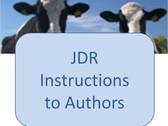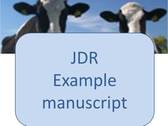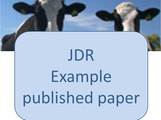Guidance for preparing manuscripts for submission to JDRWe are very pleased that you are considering publishing in Journal of Dairy Research, the international journal of the lactation sciences. Carefully following the advice given on this page will help you to get your research published. Please study it carefully, even if you have published with us before.
Original research may be submitted through Our JDR Scholar One either as a full paper or a research communication, but in the Journal both types will be classified as Research Article with no discrimination between the two. Please read our Publication Policy Statement or the descriptions given below to decide which is the appropriate style for your research. Take note that we strongly encourage shorter, concise and focused articles that make full use of our Supplementary File option. We also publish Research Reviews and Research Reflections, but please note that Research Reviews can be submitted by invitation only. We welcome suggestions for reviews: use the Contact Form. If you have already read the guidance and your manuscript is ready, go to Submit your Manuscript Otherwise, please continue to read the guidance given below Is JDR the right Journal for my research?
JDR is an authoritative international peer-reviewed Journal focused on the science of lactation. We interpret lactation broadly.The remit covers the dairy foods chain:
JDR is a specialised interest Journal with a broad remit. For research at the extremities of this range, it is necessary that a clear link to more central parts of the remit can be demonstrated. For instance, animal nutrition per se is unlikely to be publishable, but nutrition that affects the physiology of the lactating animal or impacts on milk yield or composition is welcomed. Equally, processed dairy product technology that has no relationship to any aspect of the primary production is unlikely to be publishable, unless there is a clearly demonstrated benefit to the consumer. JDR does not prioritise between different parts of the central remit, and it does not categorise published articles. Each issue will follow the dairy foods chain, so the issue will typically start with feeding related articles and finish with consumer related. JDR considers submissions as Research Papers and Research Communications. Research Papers report hypothesis-driven research of international impact. Research Communications are shorter. In addition to international impact research, JDR Research Communications can also report descriptive studies of regional or technical interest. JDR subscribes to the view that good research exists in different forms and can be communicated in different ways, so the Journal does not prioritise one type of article above the other and there is no categorisation by article type: ion the published Jopurnal all original research appears as Research Articles. JDR strongly encourages brevity and clarity. All original research (whether submitted as Research Paper or Research Communication) can be published with an associated Supplementary File that provides supporting materials, in order to focus the main article on the essential information. Using this option will increase your chances of publication and you are strongly advised to do so. JDR also publishes Research Reviews and Research Editorials. These categories are by invitation only. JDR is published 4 times per year. In addition, articles accepted for publication are published online as First View papers as soon as the proof is approved. JDR has no page charges. Publication is free, with the exception of colour images. These are free in the online version but there will be a charge if you choose colour images in the hardcopy Journal. We normally recommend authors to opt for colour online and black/white hardcopy. Is my research right for JDR? To be published as a full research paper, your research must advance knowledge of lactation science in a significant way and there should be clear benefit to human society or to dairy animals. In addition, your research should be:
My research is descriptive; can I still publish in JDR?
Can JDR publish my cutting edge research quickly?
Can I publish my review article in JDR?
What are the golden rules for a good manuscript?
What are the most common mistakes, that I should avoid?
My research is relevant for JDR and I am ready to write my Research Paper. What should I do?
I am wishing to prepare a Research Communication. What should I do?
Once you are ready, go to Our JDR Scholar One to Submit your Manuscript
|
Manuscript
|
- Home
-
Latest Research
-
JDR Published Volumes
>
- JDR 91(2)
- JDR 91(1)
- JDR 90(4)
- JDR 90(3)
- JDR 90(2)
- JDR 90(1)
- JDR 89(4)
- JDR 89(3)
- JDR 89(2)
- JDR 89(1)
- JDR 88(4)
- JDR 88(3)
- JDR 88(2)
- JDR 88(1)
- JDR 87(4)
- JDR 87(3)
- JDR 87(2)
- JDR 87(1)
- JDR 86(4)
- JDR 86(3)
- JDR 86(2)
- JDR 86(1)
- JDR 85(4)
- JDR 85(3)
- JDR 85(2)
- Vol 85(1)
- Vol 84(4)
- JDR 84(3)
- JDR 84(2)
- JDR 83(3)
- JDR 84(1)
- JDR 83(4)
- JDR 83(2)
- JDR 83(1)
- First View Articles
- DairyCare Special Issue
- Papers for Community Peer Review >
- Editorials
- Reviews
- Collected Abstracts
- Foreign Language Abstracts
- PhD Thesis Abstracts
- Research clusters >
- Latest content infographic
-
Conferences and Workshops
>
-
JDR Published Volumes
>
- For authors
- For reviewers
- Editorial Office
- Home
-
Latest Research
-
JDR Published Volumes
>
- JDR 91(2)
- JDR 91(1)
- JDR 90(4)
- JDR 90(3)
- JDR 90(2)
- JDR 90(1)
- JDR 89(4)
- JDR 89(3)
- JDR 89(2)
- JDR 89(1)
- JDR 88(4)
- JDR 88(3)
- JDR 88(2)
- JDR 88(1)
- JDR 87(4)
- JDR 87(3)
- JDR 87(2)
- JDR 87(1)
- JDR 86(4)
- JDR 86(3)
- JDR 86(2)
- JDR 86(1)
- JDR 85(4)
- JDR 85(3)
- JDR 85(2)
- Vol 85(1)
- Vol 84(4)
- JDR 84(3)
- JDR 84(2)
- JDR 83(3)
- JDR 84(1)
- JDR 83(4)
- JDR 83(2)
- JDR 83(1)
- First View Articles
- DairyCare Special Issue
- Papers for Community Peer Review >
- Editorials
- Reviews
- Collected Abstracts
- Foreign Language Abstracts
- PhD Thesis Abstracts
- Research clusters >
- Latest content infographic
-
Conferences and Workshops
>
-
JDR Published Volumes
>
- For authors
- For reviewers
- Editorial Office





